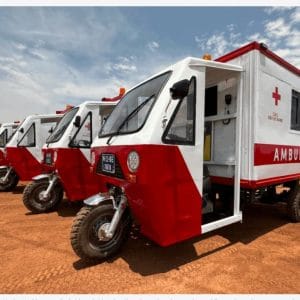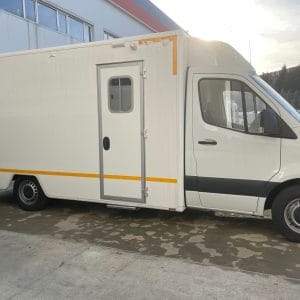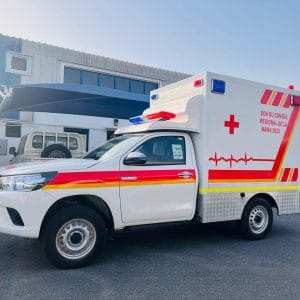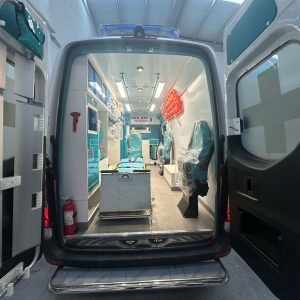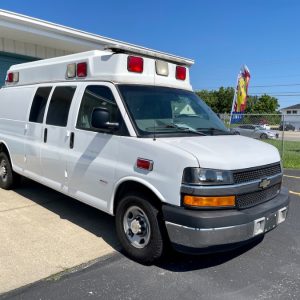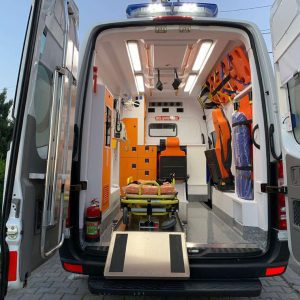1. Introduction to Ambulances
Toyota Ambulance Specifications, primarily used to transport injured or unwell people to a hospital or other medical facility. This can include doctors, nurses, and other healthcare professionals, as well as those who work in administration and support services. Speed is a key focus, as often the patient’s life can be saved if they receive medical treatment quickly. The design and size of the ambulance depend on the needs of the community it serves. For example, in low population areas, emergency medical services may operate out of pickup trucks with special modifications, whereas in metropolitan areas, an entire fleet of advanced vehicles is required. Ambulances are equipped with flashing lights and sirens, used to warn other road users of the imminent arrival of emergency personnel and to deter other vehicles from moving into their path.
Various types of ambulances are available: some, in addition to the patient compartment, have a separate box or tent enclosure used for medical activities; the design of the ambulance can be based on a van or a modified bus or truck, with a variety of emergency rescue and patient healthcare equipment including vehicle extrication tools and defibrillators; larger ambulances are called Patient Transport Vehicles and are used to transport patients for non-emergency medical appointments. Ambulance design considerations include power, wheelbase, workload, electric power supply, heating, ventilation and air conditioning, storage, ground clearance, performance in bad weather, quiet running, and emergency lights and equipment. Ambulance transport can be paid for by the patient or through the country’s public health service. In some jurisdictions, using new ambulances is required by law. Some nations also employ the use of personalized Emergency Care Assessors, Ambulance Paramedics, or Emergency Medical Technicians, who usually perform a range of patient care activities with the support of a qualified doctor or nurse.
Ambulances are the most important mode of transportation for emergency patients. They are used as patient transport vehicles when patients arrive at hospitals in emergency cases. The growing population and changing lifestyles are causing a surge in healthcare cases and increasing instances of illness, injuries, and fatalities. This has led to a surge in demand for ambulances. The technological advancements in today’s modern ambulances offer a feature-rich and high-tech transportation facility for patients. Ambulances in developed and developing nations have become standard in transporting medical emergencies. For every emergency, the patient may require different kinds of medical care, so different types of ambulances with various functionalities and features are used and available in various countries. A number of evacuation ambulances come in different varieties according to need, with basic and advanced life support ambulances available. In addition, there are different models of ambulances, and other countries are capable of hiring them and providing emergency transport services.
To assist those in need, ambulances offer practical medical assessment, treatment, and transport services. They are equipped with specialized staff who can effectively treat patients and have their skills and resources available promptly. The goal of most countries is to transport emergency patients from different sectors such as housing societies, workplaces, and communities to appropriate healthcare facilities. Ambulances are the lifeguard angels introduced in our health system by almost all nations. Some leading healthcare organizations have become an organized solution for providing equipped ambulances and comprehensive facilities for their efficient operation. The advancement in technology has led to the development of a new series of ambulances in recent times. The ambulance industry is likely to expand due to the increasing number of emergency cases.
1.1. Definition and Purpose
Ambulances are vehicles equipped with medical and trauma care systems. Patients who need critical care and are in an unstable condition are transported to a healthcare facility operating 24/7, and patients without critical conditions are transported to a hospital or clinic from home or a specific place. Ambulances are classified by the level of care they provide. There are many types of ambulances that differ according to purpose, type of care, degree of dependence on human resources, and materials. The structure of the ambulance is based on the purpose of use, so the layout varies according to whether the vehicle is an emergency patient transport vehicle or a public ambulance.
Ambulances are vehicles used to provide emergency medical care to patients in life-threatening and severe conditions, such as heart attack patients, patients with severely damaged injuries, and childbirth patients. The main purpose of ambulances is to allow patients to receive medical care in the vehicle and to transport them to medical institutions. They have a layout that allows the emergency patient to receive immediate medical care and appropriate life-saving diagnosis and treatment on the scene. Patient transport vehicles are used to move bedridden patients from a general hospital to a nursing care facility. The purpose is to transport the patient from the medical institution to a place where they can receive nursing care. In some cases, the patient is transported directly from the hospital to their home. In the case of moving from a medical institution to a general hospital, bedridden patients are carried in police or commercial vehicles and then taken to their destination by bus. Ambulances are also equipped with various medical devices for short-term life support for patients in critical condition before being sent to the hospital. The layout of the ambulance is different depending on the patient’s medical condition or safety needs. In short, the layout of an ambulance varies depending on the purpose of use.
1.2. Evolution of Toyota Ambulance Specifications
Ambulances: Evolution and Future
The first ambulances were vehicles used to transport soldiers and low-income sick people to medical facilities. These were four-wheeled wagons, pulled by horses or mules. Their main functions were to transport the patient and, occasionally, a passenger from the point of collection to the nearest hospital. They only provided basic protection and shelter from bad weather.
Until 1800, there was no concept of emergency transportation or specialized staff to help the patient during their transfer. Modern ambulances provide advanced healthcare and look very different from old transport vehicles. The need for rapid emergency medical services led to the development and growth of the type and model of ambulances. Some recent advances in medical knowledge and equipment have affected the operational and organizational structures of ambulances. These ambulances usually include a wide range of modern equipment to enable vital life-saving functions, such as intravenous therapy and drug administration, patient resuscitation and ventilation, and electronic and clinical accessories, such as ECG and vital parameters, and advanced communication tools, such as mobile phones and two-way radios. The specifications for the build, erection, and control of ambulances represent a formal agreement, industry standards, and regulations for the provision of various necessary requirements. Standards are based on legal regulations or best practices. Regulatory and legal requirements must be met regardless of the need. The history of ambulances, their contents, and major or minor changes have been of interest to several individuals.
Today, the majority of ambulances function for purposes of emergency transportation and rapid medical intervention in different locations. Over the past several years, ambulances have evolved from vehicles for the transportation of patients to specialized vehicles for the rapid provision of emergency services by specialized medical staff. As a result, speed, time, driver capability, and accessibility in restricted zones have become more important. Therefore, the need for more detailed information and more advanced inventions has become more prominent. The manufacture of ambulances today comprises a group of well-managed activities that are specialized in building commercial and incomplete vehicles in accordance with certain international standards and patient-specific needs within the framework of high technical skills. Vehicle manufacturers, in partnership with specialized companies, capsules, and manufacturers, offer new brands, models, and capabilities. Apart from vehicle manufacturers, there are many manufacturers of ambulance capsules and special devices. Many of these companies specialize in various fields of ambulances including monitoring and advice, special treatment, resuscitation, and public services. There are organizations and associations that offer medical transportation worldwide. In Germany, the rescue and patient transportation services promote various quality models, ambulance days, and certifications so that the end consumer can choose the right primary and special service. The first specialized ambulance was the “air ambulance,” which was used in the Moravian military to transport wounded troops over two planes, which were joined by a wooden platform and installed on a seat with a wicker chair in the environment. Aircraft pilots often caused more injuries than car accidents. Modern ambulances are mobile intensive care and hospital wards, with the device and personnel to end up running through the most busy and precious environment. The use of all available resources for emergency personnel transport is the only idea behind emergency personnel activities.
2. Toyota Ambulance Models
While Toyota is not as famous as some manufacturers for their ambulances, they do make some of the most incredible emergency vehicles in the world. Toyota has a list of several different ambulance models it offers for emergency and non-emergency medical services, most of which were designed from the ground up with input from emergency services. These include the popular Toyota Hiace ambulance conversion, Toyota Land Cruiser, and Toyota Hiace van-based ambulances, emergency 4x4s, and more. Toyota ambulances are some of the best built and most capable in emergency medical services. Toyota has a reputation for excellence in automotive engineering, and this carries over to their ambulance products.
Toyota currently offers four ambulance models designed uniquely for the Japanese healthcare market, including: LS50, LX10, LF50, and HH20. These models offer diverse appeal, with each of them designed to meet the specific needs of emergency and disaster support services and health clinics. They have been well-received in the context of structural flexibility and operating environments. The ambulances have reportedly impressed with their spacious interior, low entrance, blue lights and siren, sufficient loading access, and available optional equipment. These new models allow for the four movements with a stretcher as well as loading a patient who comes in on a cushioned trolley or a lying stretcher incline vehicle. While the length and wheelchair space differ between vehicles, they can be adjusted depending on the use of the stretcher. The onboard ECG system is effective in diagnosing diseases by running quick and precise examinations during transit treatment. The LED lighting in the roof panel helps brighten the interior, providing a comfortable environment for examining and treating patients. The specific advantages and main features of the Toyota ambulances are outlined in a table. Toyota’s main advantages in ambulance manufacturing include affordability, customization, and dependability, among others. Toyota releases its models into the emergency vehicle market rather frequently, preferring to fit the vehicles to customer specifications with extensive customization. Generic Toyota ambulances are assembled in the capabilities of the Adaptive Business, where value is determined by continuous interaction with the patient for healthcare and outcome management. According to customer feedback, Toyota ambulances are very popular for on-the-spot and cook scenarios, non-urgent patient transfers, and low acuity patient assessments; crews love them primarily because of the soft air rear suspension. Toyota ambulances are simply seen as a whole list of vans in the marketplace, more than anything else.
2.1. Overview of Toyota Ambulance Lineup of Toyota Ambulance Specifications
Toyota Emergency Medical Service (EMS) ambulances are designed to fulfill different requirements of the modern healthcare industry. The Land Cruiser 70 Prado is designed to fulfill the requirements of basic life support ambulances. The Land Cruiser 200 and 78 hardtop extended body are designed for critical care, life support, and patient transfer with complete patient monitoring. The Land Cruiser 200 is delivered in two different configurations: box type, which is preferred for urban roads and long-distance travel, and passenger type, which is preferably designed for long distances and off-road use. These ambulances are available globally, including in various countries. These ambulances are also in great demand by various military and healthcare organizations.
Toyota currently has an extensive range of ambulances, which are highly appreciated in the EMS field of ambulance/I.C.U. The Toyota ambulance range comprises the Land Cruiser 79, the Land Cruiser 200, and the Land Cruiser 78. The Land Cruiser 200 has three configurations, which include the box type ambulance, the passenger type ambulance, and the extra long wheelbase passenger ambulance. In the second configuration, the window-in-window would be optional. These high-featured ambulances are more reliable, luxurious, and equipped with the latest technologies. The complete product line is proposed to facilitate the EMS community by offering multiple options from basic to critical care, and emergency to transfer patient ambulances with operational and territorial applications. The Land Cruiser 200 and 78/79 series ambulances are preferred products in various organizations.
2.2. Key Features and Technologies of Toyota Ambulance Specifications
Ambulances form an integral part of modern advanced emergency services. They serve as the primary healthcare centers and are meant to provide initial healthcare facilities to patients in emergencies and accident cases. Any feature or system developed or modified for the betterment of these products would have a direct impact on the improvement of the patient’s well-being.
Toyota’s ambulances currently consigned to the domestic market use various advanced systems and features that can clearly differentiate these ambulances from the others. The main systems and features include the following:
1. Equipped with an advanced life-saving system: Many of Toyota’s ambulances are equipped in different variations with a single infrascanner or a patient management system. This system could read the vital parameters of the patient inside the ambulance. Hence, the emergency stabilization facility of the patient can be initiated there itself, even before the patient reaches the hospital.
2. Communication systems: Ambulances are equipped with advanced communication systems so that the patient’s condition can be communicated to the emergency department of the hospital even before the ambulances arrive. This reduces the time taken to initiate emergency service procedures.
3. Advanced safety technologies: The ambulances are built with advanced safety technologies that can protect the patients inside and also interact with other automobiles. Their safety feature is reflected in various tests, and hence they attain a 5-star safety rating. In case of a collision, the SOS system can initiate an emergency service call and inform the service providers about the accident. The GPS system equipped in ambulances would help them to quickly reach the accident spot.
4. Ergonomics: The patient compartment is ergonomically designed. This efficient and practical interior helps the doctors and nurses carry out the task of medical care in a more practical manner.
5. Eco-friendly technology: Toyota intends to reduce the maintenance and operation cost of the fleet operator and at the same time emit no exhaust pollutants. Thus, they designed the intake layout in such a manner that it is more fuel-efficient with better combustion and less or no exhaust pollutants.
6. Ambulance driver assist: The ambulance has various human-assist features even for trail driving.
7. Image enhancement: The ambulance exterior has a special coat on the paint in case of accidents. The paint is not damaged by the impact, and at normal room temperature conditions, it comes back to its original condition.
With all these features, the market analysis and feedback from medical personnel could definitely conclude that the Toyota ambulances are far ahead of those competing in the segment.
3. Technical Specifications of Toyota Ambulance Specifications
Toyota Ambulance Specifications
3. Technical Specifications To evaluate the real performance of Toyota ambulances, the company has stated 13 practical ambulance specifications. These essential specifications describe the ambulance’s actual performance quantitatively. This element is the most important aspect of a proper ambulance, and Toyota ambulances are competent in these crucial failure criteria. Toyota ambulances are the first choice for case submission patients because their fifty-two ambulances can obtain good values. Moreover, VANET cellular side results estimated enough ambulances for patient retrieval. The six ambulances have fuel costs of 18,000 baht as the most exceptional operation. The new ambulances are for other case submissions.
3.1. Engine Capacity This includes five diesel turbo engines, and there are four states of nominal speed at a six-cylinder engine. Because this is a diesel engine and has a turbocharged feature, not all nominal speed modes can be obtained.
Specifications: – 2,982 cc – 5,200-5,600 rpm – 16 valves – 163 hp – 258 lb-ft – 12.9 km/l – 80 L
3.2. Physical Features 3.2.1. Interior Dimensions – 2,850 × 1,910 × 360 mm – 61° – 5 persons
2. Wheel Base: 3,000 mm 3. External Dimension: 5,910 × 2,045 × 2,280 mm 4. Vehicle Load: 1,960 kg 5. Vehicle Volume: 11-16 m³
• 3 Persons Standard Ambulance. Available Patient • Inside Dimension: 2,910 × 1,520 × 1,780 mm (L × W × H) • Rear Outside Dimension: 2,000 mm × 1,800 mm • Cargo Floor Height: 650 mm • Patient Compartment Space with 2 Stow-A-Way Attendant Seats. FWD and AWD models available.
3.2.2. Exterior Dimensions Vehicle length “L”: 5,910 mm Width (distance between ambulance walls “W”): 2,045 mm Vehicle height “H”: 2,280 mm Wheel Base: Wheel to Wheel Base: R-MMR/17 WB: 3,250 mm Cargo Interior Length of the Cargo Compartment: 2,250 mm Segment Height: 23″, 32″ (58.4 cm, 81.3 cm), 20″, 23 Mi-inch (50.8 cm, 81.38 cm, 58.4 cm, 63.5 cm) Overall Width (Side Rail to Side Rail): 1,943 mm Overall Interior Length: 12 ft. 11 in inside (2,972 mm) Cabinet Length: 12 ft. 6.5 in (3,810 mm deep) Exterior Door Opening: 5 ft. 4 in (1,626 mm high) × 2 ft. 8.25 in (819.15 mm wide) Exterior Door Hold Back: 3 in (76 mm wide) Interior Dimensions Height: 60 in with cutouts front and rear. • Length: 144 in floor to roof in front half • Length: 126 in floor to roof in rear half • Volume: 240 ft³ (6,885 L)
3.2.3. Ambulance Weight: 8,400-8,600 lb GVWR: 14,400-14,600 lb
3.3. Performance Timing of acceleration and braking, initiating procedures, and tactical direction changes are considered to describe the vehicle’s performance. Response time needed from both drivers, vans, and speed vehicle operation procedures. Variability in acceleration response time at the optimal, left, and right turn movements, acceleration at T-intersection, and connected T-intersection. Braking distance needed, along with the trunk space available per specification. – Horsepower: This is defined with the D-RPM and the maximum horsepower rating with their specified RPM. – Torque: This is used in overall design; we picked this engine to meet the engine capacity. – Fuel Efficiency: Fuel efficiency is measured in kilometers per liter (km/l). – Tank Volume: The tank volume is measured in liters (L).
3.1. Engine and Performance of Toyota Ambulance Specifications
Engine
Ambulances require the convenience of a well-sized engine to move the vehicle. The model ambulances come with at least two engine combinations: a gasoline engine and a hybrid engine. Gasoline engines are far less reliable because they can only perform less than some million impacts per minute in comparison to an electric motor. Furthermore, they need more time to speed up or decelerate when the fuel pedal is operated from idle to full speed. In contrast, electric motors can produce faster and more uniform performance compared to the gasoline model. This ensures that the new hybrid-spec model saves running costs while operating at the same time. The hybrid system is more reliable than that of the gasoline system used in ambulances.
Performance
The 2.8-liter diesel engine mobilizes a maximum power of 151 hp and 300 Nm of torque. The top-running engine ensures gradual and gentle acceleration, while the upper end delivers impressive fuel economy and low vehicle emissions. Besides the performance of the automobile, the engine is well targeted at medical emergencies. Specifically intended for emergency use, the vehicle ensures acceleration and speeds suitable for dispatchers’ requirements. In the meantime, the V-8 engine and V-6 ensure the same level of vigor. The 6-speed automatic transmission has two key functionalities: power transition and economic performance at the same time. It is quick and provides just enough power at a given point. It is an automatic with a single lock-up torque converter control valve mounted. The adoption of constant and regular speed through the gear improves engine performance, increases the smooth transfer of power, and reduces shudder, while actively controlling the powertrain and the speed of the transmission. This style of transmission is generally easy to repair and maintain. It is easy, though somewhat limited, to repair better and economically as well. It requires no expertise but can be maintained within a specified time. In addition to providing reliability and inactivity to address medical emergencies without warnings and return to service.
3.2. Interior and Exterior Dimensions of Toyota Ambulance Specifications
A comprehensive and full-depth study of the interior and exterior dimensions of the ambulances is given in this section. As a rule, the ambulances in the Japanese market have relatively large passenger compartments as well as external bodies. The interior height is an important design factor that makes it easy for medical personnel to move around and provide adequate care services to the patient during transport. In addition, the exterior body height, width, and overall length also need to be considered to ensure that the vehicle meets the technical standards and regulations governing.
The suitability of the interior measurements for appropriate positioning of the emergency medical personnel and their equipment is another consideration. When considering the design and layout of the patient compartment, it must fit common emergency care requirements; thus, the layout of the two ambulances may be easier to accommodate. Further, an ambulance is intended for operation in urban or suburban areas – narrow and rigid roads – as opposed to wider rural roads with heavier-duty work requirements that need to be addressed when the design is finalized. Inside the spacious cab of the ambulances, medical personnel work in a squat and sit stance so that they can care for patients. Design parameters, such as seat and standing room dimensions, need to be considered to ensure they are suitable for clinical requirements and personnel’s physical factors. All head and clinician seat positions can accommodate their personal protection equipment; the back panel dimension is also important to fit and open such equipment. By working with display models, non-space-efficient interior features can be identified.
Relevant measurements include lower and upper ambulance dimensions, frontal oblique cabin measurements, and vertical and horizontal patient bed measurements. Overall interior vertical design height minimizes the number of occurrences of a ducking requirement to a minimum. Patient bed length variation: The patient bed length variation encompasses the two frequently seen designs, bed head and bed entry arrangements. The new problem solved by comparing the overall horizontal patient bed length is as described above. Unlike the design notation, two constraints are introduced into the qualitative description as a result of the practice of dimensions that can be readily constructed. Over-height design is a relatively important attribute that has a direct impact on the vehicle’s ability to pass under low overhead structures. Standard road traffic locations and narrow lanes can place a proprietary participant’s descriptions at risk of exposure to and interaction with sample acute care facilities. Studies aim to create an ambulance design that can alleviate the uncertainty of the cognitive model without contradicting the established norms. The overall vertical design height is mentioned in the qualitative diagrams. The previously stated study is long, and therefore the order and groupings of design dimensions are used to aid in the reporting of lengthy data that have not previously been reported. Measurements obtained using appropriate drawing tools are based on at least one cab copy of the complete motor vehicle.
4. Safety Features of Toyota Ambulance Specifications
The comprehensive array of standard safety equipment found onboard the Land Cruiser is reflected in the driver and crew compartment of the Toyota Ambulance. In such a highly critical role, the patient’s welfare and the driver are of paramount importance. Therefore, the availability of advanced driver-assistance systems that can prevent and lessen the severity of accidents and contribute to the maintenance of situational awareness to lessen operational risk is prioritized.
To ensure the safety of the patient as well as medical personnel and the driver when traffic accidents or emergency treatment are necessary, a wide array of safety equipment is installed in the ambulance such as: (1) air suspension that allows the stretcher platform to be lowered to enable more convenient entry and exit for stretcher patients; (2) attachment points for rearward and forward facing seats; (3) ambulance-specific equipment; (4) 12V power supply for equipment; (5) available rotatable swivel seats to allow increased visibility and communication for the medical staff attending to the patient; and (6) emergency lighting and powered door for sheltered patient embarkation. Hospitals must also play their part in safety preparation by providing appropriate training in ambulance configuration and usage to medical personnel involved in patient transportation. The ambulance is the infrastructure that is used to transport patients and equipment to medical facilities. In addition to potentially exacerbating the patient’s condition, accidents can be unexpected and result in significant damages and major delays for the medical institution. For the above reasons, it is important that the vehicle used to transport patients to hospitals boasts not only comfortable seating for the medical staff involved in patient transportation and life-saving equipment, but also advanced safety equipment to protect patients and medical staff from traffic accidents.
4.1. Standard Safety Equipment of Toyota Ambulance Specifications
Toyota Ambulance Specifications; Standard safety equipment forms the basis of passenger protection in an ambulance. In Toyota ambulances, it is mandatory for the patient to use the seat belt marked by DO NOT OCCUPY, which also means that the seat must be rotated to the forward-facing ward view. These tests led to the conclusion that Full Field Human Testing is no longer recommended for this type of vehicle. Mandatory airbags are available for the vehicle seats. Associated airbags and seat belt pretensioners are installed together with insecure actuated restraint systems. The service brake system intensifies the vehicle at a minimum engine speed of 900 rpm. The service brake test is applied twice; once under loaded and once under empty conditions. In addition, ambulances have a skirt-moded anti-lock braking system with the technical features to which are applied the specifications outlined by the European norms. Fire and rescue services regularly conduct vehicle orientation for crew. The ambulance doors can be opened from both inside and outside using the outside door handle or using the inside door handle. From the inside, the door can always be opened by unlocking the door using the power lock system, which naturally disengages the lock system preventing entry. All the aforementioned components of the vehicle also conform to the specifications. Compliance provides assurance that there are no gaps greater than 7 mm between items of medical equipment installed or provided and the vehicle’s internal structure.
4.2. Advanced Safety Systems of Toyota Ambulance Specifications
The seventh generation HiAce Grand Cabin and the sixth generation GranAce are equipped with advanced systems designed to help prevent collisions in a number of different situations. These include Collision Avoidance technology that detects other vehicles, pedestrians, and cyclists ahead of the vehicle; Lane Departure Alert that can detect when the vehicle is unintentionally departing from its lane and alerts the driver; and Road Sign Assist. These vehicles are also equipped with Adaptive Cruise Control and Forward Recognition Monitoring, which can help maintain a safe distance from the vehicle in front.
Toyota Ambulance Specifications; These systems and standalone sensors are designed to work in a complementary, layered approach to support and not replace the driver. They include audible as well as visual alerts and vehicle brakes. The effectiveness of these systems in the real world has been tested using emergency vehicles, which allows an evaluation based on the actual transition by an ambulance. The system is also designed to complement the vehicle’s standard safety features, including front, side, and both forms of curtain-shield airbags. Real-world testing also includes similar tests scheduled for a rear transient collision scenario and a rear scenario with a workbox. The algorithm continues to be updated and advanced in regard to safety features. While we are unable to confirm specific details as to its application in connected emergency vehicles at present, it covers intersection assist and left turn assist, to name a few.
5. Conclusion and Future Developments of Toyota Ambulance Specifications
Toyota Ambulance Specifications we comprehensively studied the specifications of Toyota ambulances. We hope that this information will be useful in better understanding the Toyota ambulance. We found that the Toyota-type ambulance has evolved along with the transition of each series of the HiAce, HiMedic, and RegiusAce models, representing the development of the demands of emergency medical services. The predecessor of the HiMedic series was developed through the joint efforts of various companies, which is the original equipment manufacturer of type D in Japan, and Toyota Auto Body Co., Ltd., an OEM of Toyota. Therefore, Toyota has been involved in the ambulance development process to some extent. However, from the HiMedic series, the ambulance was developed uniquely by Toyota itself. Our results suggest that emergency medicine technologies for emerging needs were achieved by Toyota, which has historically been strong in engineering, making use of styling design and driving performance.
Looking at the trends in technical specification requirements, the need for safety features has increased. Considering the increasing demand for advanced driver-assistance systems due to future decreases in transportation accidents, as well as telemedicine, it is certain that the further introduction of technologies such as automation and connectivity to the Toyota ambulance will be required. This will require more research on human factors and emergency medical care than ever before. Furthermore, due to the global shortage of workers in developed countries, it is necessary to develop an ambulance that motorists can provide mutual support through first aid. In addition, this should be considered in conjunction with the latest advances in medical hardware, including electric cars. Based on this research, it is necessary for Toyota, the driving association, and the driving processing regulatory authority to continue their collaboration with healthcare. Also, as humans and their surroundings change, there should be continued improvements in the Toyota-type ambulance to keep up with the times while maintaining Toyota’s protected core values.



